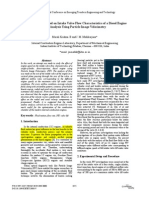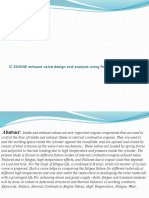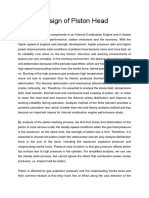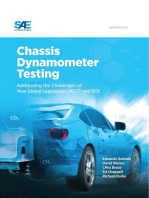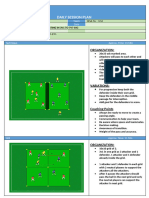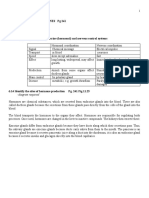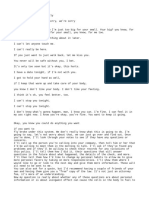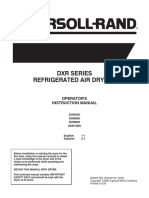Wankel Engine
Wankel Engine
Uploaded by
Muhammad Bin RiazCopyright:
Available Formats
Wankel Engine
Wankel Engine
Uploaded by
Muhammad Bin RiazCopyright
Available Formats
Share this document
Did you find this document useful?
Is this content inappropriate?
Copyright:
Available Formats
Wankel Engine
Wankel Engine
Uploaded by
Muhammad Bin RiazCopyright:
Available Formats
Lab Manual
STUDY OF WANKEL ENGINE
MISS ATIYA SADIQ
HITEC UNIVERSITY TAXILA
Thermodynamics Lab Manual Prepared By: Miss Atiya Sadiq
HITEC University Taxila
Department Of Mechanical Engineering
Lab Manual
Study of Wankel/Rotary Engine
Objective:
1. To study the engine.
2. Difference between internal combustion and external combustion engine.
3. Components of a Wankel engine.
4. Working of a Wankel engine.
5. Thermodynamics of a Wankel engine.
6. Merits and demerits
Theory:
In this experiment we will study the working of steam engine which is type of heat
engine, so we will discuss heat engines first.
- Heat Engine:
In thermodynamics, a heat engine is a system that performs the
conversion of heat or thermal energy to mechanical energy which can then be used to
do mechanical work.[1][2] It does this by bringing a working substance from a higher
state temperature to a lower state temperature. A heat "source" generates thermal
energy that brings the working substance to the high temperature state.
The working substance generates work in the "working body" of the
engine while transferring heat to the colder "sink" until it reaches a low temperature
state. During this process some of the thermal energy is converted into work by
exploiting the properties of the working substance. The working substance can be any
system with a non-zero heat capacity, but it usually is a gas or liquid.
In general an engine converts energy to mechanical work. Heat
engines distinguish themselves from other types of engines by the fact that their
efficiency is fundamentally limited by Carnot's theorem.[3] Although this efficiency
Thermodynamics Lab Manual Prepared By: Miss Atiya Sadiq
limitation can be a drawback, an advantage of heat engines is that most forms of
energy can be easily converted to heat by processes like exothermic reactions (such as
combustion), absorption of light or energetic particles, friction, dissipation and
resistance. Since the heat source that supplies thermal energy to the engine can thus be
powered by virtually any kind of energy, heat engines are very versatile and have a
wide range of applicability.
Heat engines are often confused with the cycles they attempt to mimic. Typically
when describing the physical device the term 'engine' is used. When describing the
model the term 'cycle' is used.
We have two types of heat engines:
1. Forward heat engines, which operate on forward
Carnot cycle, like all practical engines are
working. E.g. Petrol engine, Diesel engine, steam
engine etc.
2. Reverse heat engines are those heat engines which
operate on reverse Carnot cycle opposite to the
first type. E.g. Heat pumps, refrigerators etc.
Forward Carnot Cycle Reverse Carnot Cycle
We are here studying forward heat engines which operate on forward Carnot cycle.
Thermodynamics Lab Manual Prepared By: Miss Atiya Sadiq
Forward Heat engines are of two types mostly used:
- Internal Combustion engines
- External Combustion engines
- Internal Combustion engine:
The internal combustion engine is an
engine in which the combustion of a fuel (normally a fossil
fuel) occurs with an oxidizer (usually air) in a combustion
chamber that is an integral part of the working fluid flow
circuit. In an internal combustion engine (ICE) the expansion
of the high-temperature and high-pressure gases produced by
combustion apply direct force to some component of the
engine. The force is applied typically to pistons, turbine
blades, or a nozzle. This force moves the component over a
distance, transforming chemical energy into useful mechanical
energy.
The term internal combustion engine usually refers to
an engine in which combustion is intermittent, such as the more familiar four-stroke
and two-stroke piston engines, along with variants, such as the six-stroke piston
engine and the Wankel rotary engine. A second class of internal combustion engines
use continuous combustion: gas turbines, jet engines and most rocket engines, each of
which are internal combustion engines on the same principle as previously described.
- External Combustion Engine:
An external combustion engine (EC engine) is a heat engine
where an (internal) working fluid is heated by combustion in an external source,
through the engine wall or a heat exchanger. The fluid then, by expanding and acting
on the mechanism of the engine, produces motion and usable work. The fluid is then
cooled, compressed and reused (closed cycle), or (less commonly) dumped, and cool
fluid pulled in (open cycle air engine).
Thermodynamics Lab Manual Prepared By: Miss Atiya Sadiq
We will study the Wankel engine which is a type of internal combustion heat
engine.
- Wankel Engine:
The Wankel engine is a type of internal combustion engine using
an eccentric rotary design to convert pressure into rotating motion. Over the
commonly used reciprocating piston designs the Wankel engine delivers
advantages of: simplicity, smoothness, compactness, high revolutions per minute
and a high power to weight ratio. The engine is commonly referred to as a rotary
engine, though this name applies also to other completely different designs. Its
four-stroke cycle occurs in a moving combustion chamber between the inside of an
oval-like epitrochoid-shaped housing and a rotor that is similar in shape to a
Reuleaux triangle with sides that are somewhat flatter.
- Components of a Wankel Engine:
A rotary engine has an ignition system and a fuel-delivery
system that are similar to the ones on piston engines. If you've never seen the inside of
a rotary engine, be prepared for a surprise, because you won't recognize much.
1. Rotor:
The rotor has three convex faces, each of which acts like a piston. Each face
of the rotor has a pocket in it, which increases the displacement of the engine,
allowing more space for air/fuel mixture.
At the apex of each face is a metal blade that forms
a seal to the outside of the combustion chamber.
There are also metal rings on each side of the rotor
that seal to the sides of the combustion chamber.
The rotor has a set of internal gear teeth cut into
the center of one side. These teeth mate with a gear
that is fixed to the housing. This gear mating
determines the path and direction the rotor takes
through the housing.
Thermodynamics Lab Manual Prepared By: Miss Atiya Sadiq
2. Housing:
The housing is roughly oval in shape (it's actually
an epitrochoid -- check out this Java
demonstration of how the shape is derived). The
shape of the combustion chamber is designed so
that the three tips of the rotor will always stay in
contact with the wall of the chamber, forming
three sealed volumes of gas.
Each part of the housing is dedicated to one part
of the combustion process. The four sections are:
Intake
Compression
Combustion
Exhaust
The intake and exhaust ports are located in the housing. There are no valves in these
ports. The exhaust port connects directly to the exhaust, and the intake port connects
directly to the throttle.
3. Output Shaft:
The output shaft has round lobes mounted eccentrically, meaning that they are offset
from the centerline of the shaft. Each rotor fits over one of these lobes. The lobe acts
sort of like the crankshaft in a piston engine. As the rotor follows its path around the
housing, it pushes on the lobes. Since the lobes are mounted eccentric to the output
shaft, the force that the rotor applies to the lobes creates torque in the shaft, causing it
to spin.
The whole assembly of the Wankel engine is shown in the figure below.
Thermodynamics Lab Manual Prepared By: Miss Atiya Sadiq
- Working of Wankel Engine:
In the Wankel engine, the four strokes of a typical Otto
cycle occur in the space between a three-sided symmetric rotor and the inside of a
housing. In each rotor of the Wankel engine, the oval-like epitrochoid-shaped housing
surrounds a rotor which is triangular with bow-shaped flanks (often confused with a
Reuleaux triangle, a three-pointed curve of constant width, but with the bulge in the
middle of each side a bit more flattened). The theoretical shape of the rotor between
the fixed corners is the result of a minimization of the volume of the geometric
combustion chamber and a maximization of the compression ratio, respectively. The
symmetric curve connecting two arbitrary apexes of the rotor is maximized in the
direction of the inner housing shape with the constraint that it not touch the housing at
any angle of rotation (an arc is not a solution of this optimization problem).
The central drive shaft, called the eccentric shaft or E-shaft,
passes through the center of the rotor and is supported by fixed bearings. The rotors
ride on eccentrics (analogous to crankpins) integral to the eccentric shaft (analogous to
a crankshaft). The rotors both rotate around the eccentrics and make orbital
revolutions around the eccentric shaft. Seals at the corners of the rotor seal against the
periphery of the housing, dividing it into three moving combustion chambers. The
rotation of each rotor on its own axis is caused and controlled by a pair of
synchronizing gears. A fixed gear mounted on one side of the rotor housing engages a
ring gear attached to the rotor and ensures the rotor moves exactly 1/3 turn for each
turn of the eccentric shaft. The power output of the engine is not transmitted through
the synchronizing gears.[28] The force of gas pressure on the rotor (to a first
approximation) goes directly to the center of the eccentric, part of the output shaft.
Thermodynamics Lab Manual Prepared By: Miss Atiya Sadiq
The heart of a rotary engine is the rotor. This is roughly the
equivalent of the pistons in a piston engine. The rotor is mounted on a large circular
lobe on the output shaft. This lobe is offset from the centerline of the shaft and acts
like the crank handle on a winch, giving the rotor the leverage it needs to turn the
output shaft. As the rotor orbits inside the housing, it pushes the lobe around in tight
circles, turning three times for every one revolution of the rotor.
As the rotor moves through the housing, the three chambers created by the rotor
change size. This size change produces a pumping action. Let's go through each of the
four strokes of the engine looking at one face of the rotor.
Intake:
The intake phase of the cycle starts when the tip of the rotor passes the intake port. At
the moment when the intake port is exposed to the chamber, the volume of that
chamber is close to its minimum. As the rotor moves past the intake port, the volume
of the chamber expands, drawing air/fuel mixture into the chamber.
When the peak of the rotor passes the intake port, that chamber is sealed off and
compression begins.
Compression
As the rotor continues its motion around the housing, the volume of the chamber gets
smaller and the air/fuel mixture gets compressed. By the time the face of the rotor has
made it around to the spark plugs, the volume of the chamber is again close to its
minimum. This is when combustion starts.
Combustion
Most rotary engines have two spark plugs. The combustion chamber is long, so the
flame would spread too slowly if there were only one plug. When the spark plugs
ignite the air/fuel mixture, pressure quickly builds, forcing the rotor to move.
The pressure of combustion forces the rotor to move in the direction that makes the
chamber grow in volume. The combustion gases continue to expand, moving the rotor
and creating power, until the peak of the rotor passes the exhaust port.
Exhaust:
Thermodynamics Lab Manual Prepared By: Miss Atiya Sadiq
Once the peak of the rotor passes the exhaust port, the high-pressure combustion gases
are free to flow out the exhaust. As the rotor continues to move, the chamber starts to
contract, forcing the remaining exhaust out of the port. By the time the volume of the
chamber is nearing its minimum, the peak of the rotor passes the intake port and the
whole cycle starts again.
The neat thing about the rotary engine is that each of the three faces of the rotor is
always working on one part of the cycle -- in one complete revolution of the rotor,
there will be three combustion strokes. But remember, the output shaft spins three
times for every complete revolution of the rotor, which means that there is one
combustion stroke for each revolution of the output shaft.
- Thermodynamics of a Wankel engine:
The Wankel engine is operated on Otto cycle.
An Otto cycle is an idealized thermodynamic cycle which describes the functioning of
a typical spark ignition reciprocating piston engine,[1] the thermodynamic cycle most
commonly found in automobile engines.
The Otto cycle is constructed out of:
Top and bottom of the loop: a pair of quasi-parallel and isentropic processes
(frictionless, adiabatic reversible).
Left and right sides of the loop: a pair of parallel isochoric processes (constant
volume).
The isentropic processes of compression and expansion implies no loss of mechanical
energy due to friction and no transfer of heat into or out of the system during those
processes, hence the cylinder, and piston are assumed impermeable to heat during
Thermodynamics Lab Manual Prepared By: Miss Atiya Sadiq
those processes. Heat flows into the loop through the left pressurizing process and
some of it flows back out through the right depressurizing process, and the difference
between the heat added and heat removed is equal to the net mechanical work
generated.
The processes are described by:
Process 0-1 a mass of air is drawn into piston/cylinder arrangement at constant
pressure.
Process 1-2 is an isentropic and adiabatic compression of the air as the piston
moves from bottom dead Centre (BDC) to top dead Centre (TDC).
Process 2-3 is a constant-volume heat transfer to the working gas from an
external source while the piston is at top dead Centre. This process is intended
to represent the ignition of the fuel-air mixture and the subsequent rapid
burning.
Process 3-4 is an isentropic expansion (power stroke).
Process 4-1 completes the cycle by a constant-volume process in which heat is
rejected from the air while the piston is at bottom dead center.
Process 1-0 the mass of air is released to the atmosphere in a constant pressure
process.
The Otto cycle consists of isentropic compression, heat addition at constant volume,
isentropic expansion, and rejection of heat at constant volume. In the case of a four-
stroke Otto cycle, technically there are two additional processes: one for the exhaust
of waste heat and combustion products at constant pressure (isobaric), and one for the
Thermodynamics Lab Manual Prepared By: Miss Atiya Sadiq
intake of cool oxygen-rich air also at constant pressure; however, these are often
omitted in a simplified analysis. Even though those two processes are critical to the
functioning of a real engine, wherein the details of heat transfer and combustion
chemistry are relevant, for the simplified analysis of the thermodynamic cycle, it is
more convenient to assume that all of the waste-heat is removed during a single
volume change.
Process 0-1 intake stroke:
A mass of air (working fluid) is drawn into the cylinder, at atmospheric pressure
(constant pressure) through the open intake valve, while the exhaust valve is closed
during this process. The intake valve closes at point 1.
Process 1-2 compression stroke:
Piston moves from crank end (BDC, bottom dead centre and maximum volume) to
cylinder head end (TDC, top dead centre and minimum volume) as the working gas
with initial state 1 is compressed isentropically to state point 2, through compression
ratio . Mechanically this is the isentropic compression of the air/fuel mixture
in the cylinder, also known as the compression stroke. This isentropic process assumes
there no mechanical energy is lost due to friction and no heat is transferred to or from
the gas, hence the process is reversible. The compression process requires that
mechanical work be added to the working gas. Generally the compression ratio is
around 9-10:1 (V1:V2) for a typical engine.
Process 2-3 ignition:
The piston is momentarily at rest at TDC. At this instant the air/fuel mixture is
compressed at the top of the compression stroke with the volume essentially held
constant, also known as ignition phase. Heat is added to the working fluid at constant
volume by the combustion of the injected fuel. The pressure rises and the ratio
is called the "explosion ratio".
Process 3-4 expansion stroke:
The increased high pressure exerts a force on the piston and pushes it towards the
BDC. Expansion of working fluid takes place isentropically and work is done by the
system on the piston. The volume ratio is called "isentropic expansion ratio".
Mechanically this is the expansion of the hot gaseous mixture in the cylinder known
as expansion (power) stroke.
Thermodynamics Lab Manual Prepared By: Miss Atiya Sadiq
Process 4-1 idealized heat ejection:
The piston is momentarily at rest at BDC. The working gas pressure drops
instantaneously during a constant volume process as heat is removed as an idealized
external sink is brought into contact with the cylinder head from point 4 to point 1.
The exhaust valve opens at point 1 and the gas returns to state 1.
Process 4-0 exhaust stroke:
As the piston moves from BDC (point 1) to the exhaust valve opened, the gaseous
mixture is vented to the atmosphere and the process starts a new Otto cycle.
P-V Diagram
T-S Diagram
Merits And De-merits of Wankel engine:
Merits:
Prime advantages of the Wankel engine are:
Thermodynamics Lab Manual Prepared By: Miss Atiya Sadiq
A far higher power to weight ratio than a piston engine.
No reciprocating parts.
Runs with almost no vibration.
Not prone to engine-knock.
Far fewer parts than a piston engine.
Cheaper to mass-produce as contains few parts.
Superior breathing, filling the combustion charge in 270 degrees of main shaft
rotation rather than 180 degrees in a piston engine.
Supplies torques for about two thirds of the combustion cycle rather than one
quarter for a piston engine.
Wider speed range gives greater adaptability.
It can use fuel of wider octane ratings.
Does not suffer from "scale effect" to limit its size.
It is approximately one third of the size of a piston engine of equivalent power
output.
Sump oil remains uncontaminated by the combustion process requiring no oil
changes. The oil in the main shaft is totally sealed from the combustion
process. The oil for Apex seals and crankcase lubrication is separate. In piston
engines the crankcase oil is contaminated by combustion blow-by through the
piston rings.
Wankel engines are considerably lighter, simpler containing far fewer moving
parts than piston engines of equivalent power output.
De-merits:
o Rotor sealing is still a problem as the engine housing has vastly different
temperatures in each separate chamber section. The different expansion
coefficients of the materials gives a far from perfect sealing. In
comparison a piston engine has all four functions of a cycle in the same
chamber giving a more stable temperature for piston rings to act against.
o The combustion is slow as the combustion chamber is big and moving.
This causes the squeeze stream, preventing the flame from reaching the
chamber trailing side.
o Poor fuel consumption as the exhaust stream is enriched with unburned
mixture and carbon monoxide. Acceleration and deceleration as in direct
Thermodynamics Lab Manual Prepared By: Miss Atiya Sadiq
drive average driving conditions also affects fuel economy. Running the
engine at a constant speed and load eliminates poor fuel consumption.
o Poor emissions. As unburnt fuel is in the exhaust stream, emissions
requirements are difficult to meet. This problem looks to be overcome
by implementing direct fuel injection into the combustion chamber.
Thermodynamics Lab Manual Prepared By: Miss Atiya Sadiq
You might also like
- Test Anxiety Scale - Iowa UniversityDocument3 pagesTest Anxiety Scale - Iowa UniversityAlexandru SicuNo ratings yet
- Development Theories Cheat Sheet 1Document2 pagesDevelopment Theories Cheat Sheet 1api-490667843No ratings yet
- Medical Ordinance IN SRILANKADocument27 pagesMedical Ordinance IN SRILANKAtracker1234No ratings yet
- Ic EngineDocument23 pagesIc EngineGanesh kumar100% (1)
- LAB Report 01 Meen 20110104Document13 pagesLAB Report 01 Meen 20110104Zohaib Arif MehmoodNo ratings yet
- Lab Report 12Document8 pagesLab Report 12mamoona noreenNo ratings yet
- ICE Lab ManualDocument68 pagesICE Lab ManualAkhilNagNo ratings yet
- IC Engine - Lecture 1Document55 pagesIC Engine - Lecture 1darshan008No ratings yet
- Lab 1 ReportDocument6 pagesLab 1 ReportStephen JonesNo ratings yet
- ICE Lab ReportDocument34 pagesICE Lab ReportUmair Ali RajputNo ratings yet
- Four Stroke & Two StrokeDocument3 pagesFour Stroke & Two StrokeFarrukh Zia NagiNo ratings yet
- Unit 4 Flywheel: StructureDocument21 pagesUnit 4 Flywheel: StructureShivam Gupta0% (2)
- 16operation StartingadieselengineDocument76 pages16operation StartingadieselengineVijay Hanchinal0% (1)
- PER MicroprojectDocument8 pagesPER MicroprojectHARSHAL SONARNo ratings yet
- Internal Combustion EngineDocument35 pagesInternal Combustion EngineMuhammad FaizNo ratings yet
- Internal Combustion Engine: Course No: M02-052 Credit: 2 PDHDocument24 pagesInternal Combustion Engine: Course No: M02-052 Credit: 2 PDHdoxoNo ratings yet
- Internal Combustion Engines2 PDFDocument92 pagesInternal Combustion Engines2 PDFEr Satyam KunwarNo ratings yet
- 2 Stroke Diesel EngineDocument5 pages2 Stroke Diesel EngineJims Cudinyerah100% (1)
- Types of EngineDocument8 pagesTypes of EngineDegaga TegagnNo ratings yet
- Ic Engines: Four Stroke Cycle Diesel EnginesDocument11 pagesIc Engines: Four Stroke Cycle Diesel Enginesmechjobs4meNo ratings yet
- Thermal Engineering-2 PracticalDocument35 pagesThermal Engineering-2 PracticalAlok Anand100% (1)
- 1) Effect of Engine Speed On Intake Valve Flow Characteristics of A Diesel EngineDocument6 pages1) Effect of Engine Speed On Intake Valve Flow Characteristics of A Diesel EnginefitriasyrafNo ratings yet
- Applied ThermodynamicsDocument83 pagesApplied ThermodynamicsKaranNo ratings yet
- Scuderi Split CycleDocument12 pagesScuderi Split CycleManish KumarNo ratings yet
- Duke Engine ReportDocument9 pagesDuke Engine ReportDeepak Jindal100% (1)
- Operation of Multicylinder EnginesDocument3 pagesOperation of Multicylinder EnginesSujith BobbaNo ratings yet
- Unit 2 Lecture NotesDocument54 pagesUnit 2 Lecture NotessaranNo ratings yet
- MHI Develops Hybrid Turbocharger To Generate ElectricityDocument2 pagesMHI Develops Hybrid Turbocharger To Generate ElectricityJoseph100% (1)
- 3-Engine Dynamic PropertiesDocument29 pages3-Engine Dynamic PropertiesHiếu Đình NguyễnNo ratings yet
- Diesel EngineTestingDocument5 pagesDiesel EngineTestingGorilla GrooveNo ratings yet
- Valve Timing Diagram of Four Stroke EngineDocument3 pagesValve Timing Diagram of Four Stroke EngineAnurag SinghNo ratings yet
- Connecting RodDocument6 pagesConnecting RodMukul YadavNo ratings yet
- Chapter 1 - Engine Components and ClassificationDocument42 pagesChapter 1 - Engine Components and ClassificationAdib MaharunNo ratings yet
- 2-Four and Two Stroke EnginesDocument27 pages2-Four and Two Stroke EnginesAHMADNo ratings yet
- Engine Valve 1Document10 pagesEngine Valve 1LokeshRathor100% (1)
- Diesel Engine ConstructionDocument42 pagesDiesel Engine Constructionanon_322442463100% (1)
- Internal Combustion EngineDocument18 pagesInternal Combustion EnginegeorgekenjiputraNo ratings yet
- Iav Ottomotorisches Klopfen Ans PDFDocument449 pagesIav Ottomotorisches Klopfen Ans PDFengrsurifNo ratings yet
- Design Databook FinalDocument19 pagesDesign Databook FinalKumaran NarayananNo ratings yet
- Fuel Supply System Petrol EngineDocument7 pagesFuel Supply System Petrol EngineAmarChaudhary0% (1)
- Internal Combustion Engines2Document92 pagesInternal Combustion Engines2Rupinder Rp100% (1)
- Mpfi (Multi-Point Fuel Injection System)Document4 pagesMpfi (Multi-Point Fuel Injection System)Rochelle May CatbaganNo ratings yet
- Ic Engine Terminolgy PDFDocument20 pagesIc Engine Terminolgy PDFDinesh KumarNo ratings yet
- Performance of IC's EngineDocument45 pagesPerformance of IC's EngineNandhakumarNo ratings yet
- Lecture 2 - Internal CombussionDocument67 pagesLecture 2 - Internal Combussionchoongwenkang100% (2)
- Classification of Engines & Its ComponentsDocument33 pagesClassification of Engines & Its ComponentsSunil DhankharNo ratings yet
- Design of Piston HeadDocument7 pagesDesign of Piston HeadSouradeep BhattacharjaNo ratings yet
- Automobile Engineering Lab ExperimentDocument7 pagesAutomobile Engineering Lab ExperimentNidhi BharatiyaNo ratings yet
- CYLINDER FINS Final ProjectDocument84 pagesCYLINDER FINS Final ProjectUttam Animireddy100% (1)
- 2 Stroke EngineDocument4 pages2 Stroke EngineSaint BoyetNo ratings yet
- Diesel EngineDocument14 pagesDiesel EngineAyşenur Çetin100% (1)
- Flujo de Aire PDFDocument10 pagesFlujo de Aire PDFJoffre Lautaro Benavides Seminario100% (1)
- Internal Combustion EngineDocument4 pagesInternal Combustion Enginesari hafizhNo ratings yet
- Stress Analysis of Crankshaft: Mechanics of Materials (Lab Project)Document18 pagesStress Analysis of Crankshaft: Mechanics of Materials (Lab Project)Baran ShafqatNo ratings yet
- PistonDocument7 pagesPistongauravarora93100% (1)
- UNIT-8 Bearing Materials: SyllabusDocument8 pagesUNIT-8 Bearing Materials: SyllabusDebanjan SenNo ratings yet
- Engine Lubrication System: The Importance of LubricationDocument4 pagesEngine Lubrication System: The Importance of LubricationPyae Sone LonnNo ratings yet
- Chassis Dynamometer Testing: Addressing the Challenges of New Global LegislationFrom EverandChassis Dynamometer Testing: Addressing the Challenges of New Global LegislationNo ratings yet
- Lab Report 4.Document7 pagesLab Report 4.Usman Ali Usman AliNo ratings yet
- Sum MarpowDocument19 pagesSum Marpowkae simNo ratings yet
- Wankel EngineDocument8 pagesWankel EngineMuhammad Qasim JameelNo ratings yet
- Steam EngineDocument13 pagesSteam EngineMuhammad Bin RiazNo ratings yet
- Private Pilot GR Ou ND SchoolDocument85 pagesPrivate Pilot GR Ou ND SchoolMuhammad Yaumul FajriNo ratings yet
- Turbo Jet EngineDocument15 pagesTurbo Jet EngineMuhammad Bin RiazNo ratings yet
- Condensation UnitDocument7 pagesCondensation UnitMuhammad Bin RiazNo ratings yet
- Flow Boiling UnitDocument9 pagesFlow Boiling UnitMuhammad Bin RiazNo ratings yet
- Gay Lussac's LawDocument5 pagesGay Lussac's LawMuhammad Bin RiazNo ratings yet
- Steam EngineDocument13 pagesSteam EngineMuhammad Bin RiazNo ratings yet
- Pesticides Punjab Pakistan List With ContactDocument7 pagesPesticides Punjab Pakistan List With ContactSaraikistan Democratic Party100% (3)
- SPEC Tamanu OilDocument1 pageSPEC Tamanu OilSuci Desriana RSNo ratings yet
- CV & Cover Letter - DTBDocument3 pagesCV & Cover Letter - DTBDewan TufanNo ratings yet
- Sponsored Seats 2024Document4 pagesSponsored Seats 2024Girdhari Ram SauNo ratings yet
- The Spiritual Journey A Path To Self DiscoveryDocument10 pagesThe Spiritual Journey A Path To Self DiscoveryMahabir kar100% (1)
- PASS & SUPPORT SESSION PLANDocument2 pagesPASS & SUPPORT SESSION PLANsantilmul500No ratings yet
- Position PaperDocument3 pagesPosition PaperCassandra BelciñaNo ratings yet
- Laurente Kara May B. Morning in NagrebcanDocument4 pagesLaurente Kara May B. Morning in NagrebcanEahrl Andreih PlataNo ratings yet
- ADA Guidelines For Sustainable Dental Practices - FinalDocument3 pagesADA Guidelines For Sustainable Dental Practices - Finalayesharauf1No ratings yet
- Rev Commiphora-Mukul 48p DVGNDocument48 pagesRev Commiphora-Mukul 48p DVGNMSKC0% (1)
- Latihan Olimpiade Bahasa Inggris SDDocument7 pagesLatihan Olimpiade Bahasa Inggris SDGWC OFFICIALNo ratings yet
- NSTP Module 6 Disaster Workshop Revised 2021Document21 pagesNSTP Module 6 Disaster Workshop Revised 2021Hanshien Khyl VillacarlosNo ratings yet
- Price Bid Annexure IVDocument99 pagesPrice Bid Annexure IVOmar MohammedNo ratings yet
- House Hearing, 107TH Congress - Health Quality and Medical ErrorsDocument80 pagesHouse Hearing, 107TH Congress - Health Quality and Medical ErrorsScribd Government DocsNo ratings yet
- HSB The Endocrine System Csec NotesDocument4 pagesHSB The Endocrine System Csec NotesGiaaNo ratings yet
- GEO131 Chapter 1Document7 pagesGEO131 Chapter 1Devi TriyanaNo ratings yet
- DXR Series Refrigerated Air Dryers: Operator'S Instruction ManualDocument48 pagesDXR Series Refrigerated Air Dryers: Operator'S Instruction ManualDavid BarrientosNo ratings yet
- High - Speed Napkin Machine User ManualDocument28 pagesHigh - Speed Napkin Machine User ManualMURALITHHARAN100% (1)
- Power Plant Engineering Fuel and Combustion System Chpter 3Document79 pagesPower Plant Engineering Fuel and Combustion System Chpter 3mussietilahun591No ratings yet
- Rock PhosphateDocument2 pagesRock PhosphateGrignionNo ratings yet
- Fluid Flow: Wes Bussman, PH.D., Demetris Venizelos, PH.D., and R. Robert HayesDocument29 pagesFluid Flow: Wes Bussman, PH.D., Demetris Venizelos, PH.D., and R. Robert HayesrezaimamNo ratings yet
- Brain Tumour Detection and Classification by Leveraging Deep Neural NetworkDocument6 pagesBrain Tumour Detection and Classification by Leveraging Deep Neural NetworkMohammad Asim QadriNo ratings yet
- Horno Lainox 2013 04 19 14 49 40Document36 pagesHorno Lainox 2013 04 19 14 49 40Мариян СтояновNo ratings yet
- Pressure Loss For Flow Through Pipe App1Document6 pagesPressure Loss For Flow Through Pipe App1JeromeNo ratings yet
- Problem Set (Thermochemistry)Document1 pageProblem Set (Thermochemistry)feqgameaccNo ratings yet
- FSN Lullaby Warmer Resus Plus&PrimeDocument4 pagesFSN Lullaby Warmer Resus Plus&PrimemohdkhidirNo ratings yet
- Ece Laws 6849Document18 pagesEce Laws 6849Eric Chiu AusenteNo ratings yet





















